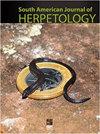Parasitic Fauna of Captive Snakes (Serpentes, Colubridae) from Northeastern Argentina
IF 0.7
4区 生物学
Q4 ZOOLOGY
引用次数: 0
Abstract
Abstract. This study aimed to evaluate the status of parasitic infections of colubrid snakes living in serpentariums in northeastern Argentina. Specimens were analyzed through clinical examination and coproparasitological surveys. In cases of death, specimens were necropsied, and histopathological exams were performed to determine its cause(s). Out of 30 specimens examined from 12 different species, parasites were found in 25 of them (83%). Nematodes were most common, with rhabdiasid and ascaridid helminths accounting for 57% and 40% of all infections, respectively. Further, the ascarid Hexametra boddaertii was identified in a specimen of Erythrolamprus aesculapii. Coccidian, digenean, and pentastomid parasites were also found less frequently. We identified the pentastomids Raillietiella furcocerca and Cephalobaena tetrapoda in specimens of Pseudablabes patagoniensis. We revealed systemic lesions induced by endoparasites, including enteritis and detachment of the gut mucosa by ascarids, tissue granulomas by rhabdiasids, and pulmonary microhemorrhages by pentastomids. Additionally, rhabdiasid-induced lesions in Duvernoy's gland were shown for the first time. Regarding ectoparasites, we identified the tick Amblyomma dissimile in a specimen of P. patagoniensis. On the whole, this study provides relevant information about the prevalence and pathophysiological effects of parasites on captive colubrids and paves the way for treatment strategies of such infections.阿根廷东北部圈养蛇的寄生区系
摘要本研究旨在评估生活在阿根廷东北部水族馆的冷蛇的寄生虫感染状况。标本通过临床检查和寄生虫学调查进行分析。在死亡病例中,对标本进行尸检,并进行组织病理学检查以确定其原因。在12个不同物种的30个标本中,有25个(83%)发现了寄生虫。线虫最常见,横纹肌病和蛔虫分别占所有感染的57%和40%。此外,在一个aesculapii红灯病毒标本中发现了蛔虫Hexametra boddaertii。球虫、双口虫和五口虫也较少被发现。我们在巴塔哥尼亚Pseudablabes patagoniensis的标本中鉴定出了五口虫Raillietiella furcerca和四足头海鱼。我们发现了由内寄生虫引起的全身性损伤,包括蛔虫引起的肠炎和肠黏膜脱离,横纹肌样引起的组织肉芽肿,以及五口虫引起的肺微出血。此外,首次显示了横纹肌样蛋白诱导的Duvernoy腺病变。关于体外寄生虫,我们在一个巴塔哥尼亚P.patagoninsis的标本中鉴定出了差异性安氏蜱。总的来说,这项研究提供了有关寄生虫对圈养润滑剂的患病率和病理生理影响的相关信息,并为此类感染的治疗策略铺平了道路。
本文章由计算机程序翻译,如有差异,请以英文原文为准。
求助全文
约1分钟内获得全文
求助全文
来源期刊
CiteScore
1.50
自引率
0.00%
发文量
10
期刊介绍:
The South American Journal of Herpetology (SAJH) is an international journal published by the Brazilian Society of Herpetology that aims to provide an effective medium of communication for the international herpetological community. SAJH publishes peer-reviewed original contributions on all subjects related to the biology of amphibians and reptiles, including descriptive, comparative, inferential, and experimental studies and taxa from anywhere in the world, as well as theoretical studies that explore principles and methods.

 求助内容:
求助内容: 应助结果提醒方式:
应助结果提醒方式:


